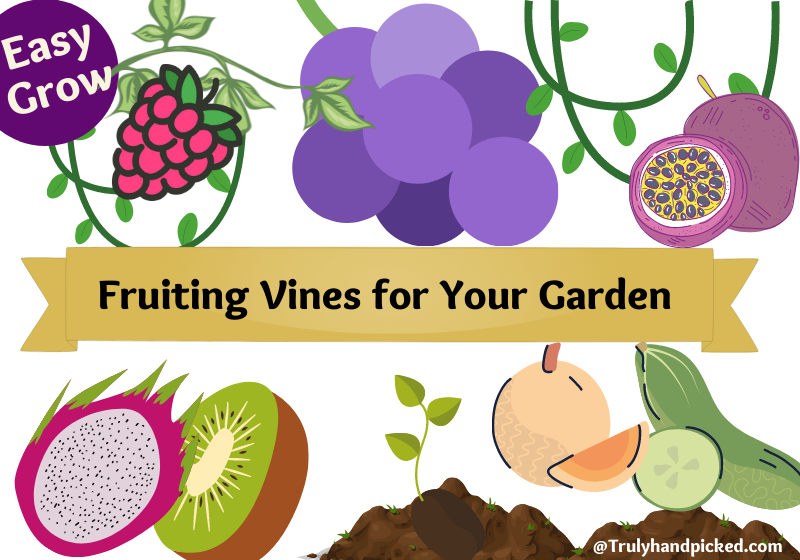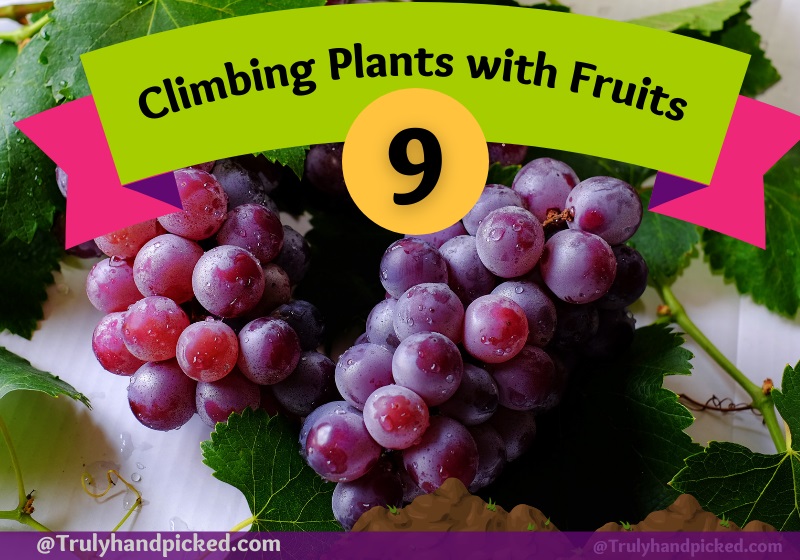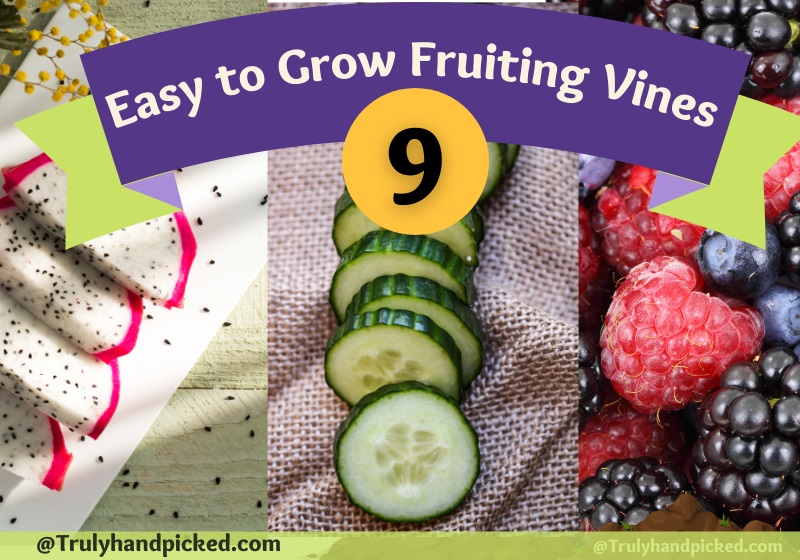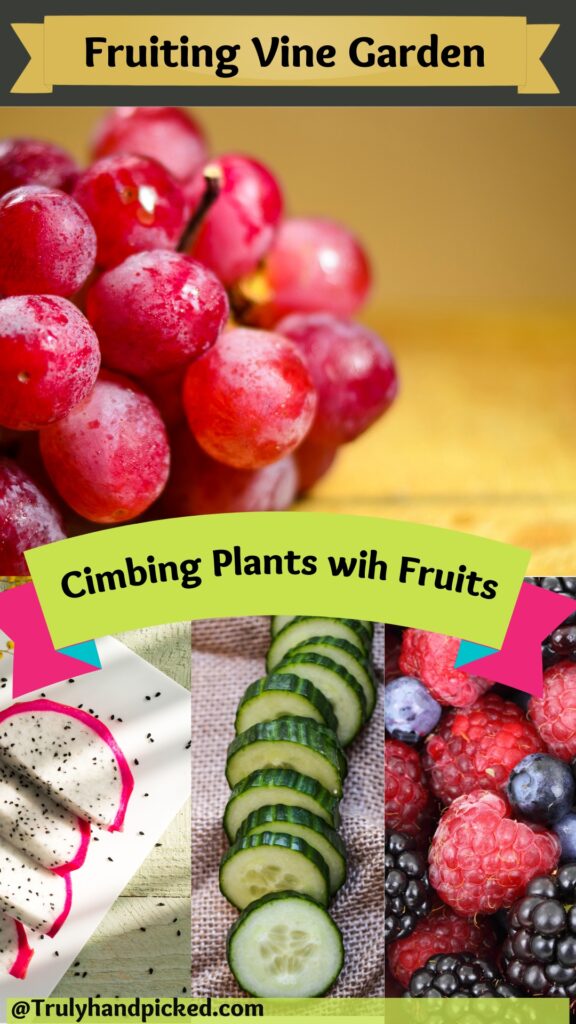Fruiting climbing plants/ fruit vines are the best option to go with if you have limited space for gardening and yet, dream of some cropping plants in your yard.
Some gardeners may fear growing climbing and vining fruit plants in vertical positions. But not to worry anymore, as we emerge with some pro tips for gardening here that will easily save you from this hassle.
Try to grow these easy-to-grow vining fruit plants in your vertical garden with the following tricks and make your harvest experience juicier than ever.
List of best fruiting vines and trained climbing plants for your garden: 1 Grapevines 2 Raspberry 3 Dragon Fruit 4 Kiwi 5 Passion Fruits 6 Blueberries 7 Cantaloupe 8 Cucumber 9 Blackberries
Few are like shrubs with better stem and few are trailing vines that can be trained on trellis for better flowers, fruit productivity and for disease free plants.
9 Easy to Grow Vines & Climbing Plants with Fruits :
About the plant:
Grapevine is the top favorite of most gardeners among the climbing and vining plants. You can choose from a wide range of varieties as grapevine has plenty of species, and each of them is easily cultivatable in your yard.
It can grow 3-20 feet long with a wide width of 6-12 feet depending on the species.
Quick Tips on Grapevines Care:
- Keep the roots of grapevine seedlings in water for 2-3 hours before planting them in the permanent bed
- Grapevine plants need bright light to thrive, so, place the pants in a sunny location in your yard
- You need to arrange nitrogen base lose yet deep soil to give your grapevine plants a jump start
- Check for good air-circulation quality for your soil as well along with well-drained benefit
- Try to provide ½-1 inch of water per week to your garden grapevine plants enough moisture for their proper growth
When can you expect the vines to give fruit: It takes more than 3 years for your vines to start bearing fruits.
Pruning: Every year running is very essential, as unpruned vines grow a lot of foliage which prevents light and lesser flower buds. And most of the energy is spent on foliage.
Harvest: Unlike other fruits, grapes don’t ripen any further after they are harvested. After you have picked them out from the vines if they are sour and acidic they won’t ripe further. If they are sweet they remain so. No ripening after out from vines.
You may also be interested in the best plants to attract birds and get bees to your garden for better pollination.
About the plant:
Raspberry is one of the easiest and fast-growing climbing fruit plants to grow in your garden. Both types of raspberry species can cultivate in your normal garden bed with moderate care.
You can prune and propagate effortlessly this juicy vining plant. They can grow 10-20 feet long and thrive more healthily if you plant directly in bare garden beds.
How to care for raspberry fruit:
- Prepare your potting soil with loamy quality with an acidic fertilizer
- This plant wants both sandy or clay-base soil, just make sure that it drains well
- Use compost or organic manure to fertilize your raspberry plants maintaining a pH level between 5.5-6.5
- The raspberry plant needs full sun so, plant them in a sunny location without any shade
- And water your raspberry plant often, once the top surface of the soil seems a little dry
- You can apply mulch to retain the water for a long while without making it soggy.
How to build posts for raspberries: building a two-wire permanent trellis
Do I need a trellis? Yes, your raspberries can grow without a trellis but over time they grow vertically, and with loads later, they tend to form an arch shape. So training in trellis for your raspberries is recommended.
Is pruning needed for this climber: Just like grapes, raspberries do need pruning. Without pruning every year they will look like a bush and the lower part of the plant receives low light. With less light, it gives lesser fruit branches and is less tasty.
Dragon Fruit:
About the plant:
Dragon fruit is one unique-looking flowering plant that can add a mesmerizing touch to your yard.
This plant can grow through any climber like trellis(vine-like cacti), fence, grill, or even a tree. It belongs to the cactus genus and thrives more vigorously while placed horizontally rather than vertically.
Requirements for this climbing cactus plant :
- Sandy soil type with good irrigation provides the best-growing facility for your dragon fruit plant
- Keep the pH level between 5.5-6.5 to get the best harvesting outcome
- This plant can stand high humidity with proper sunlight
- Maintain a climate of 65-80 degrees F temperature to give your plant the best growth
- Dry and well-drained soil is the best for dragon fruit plants and keeps your watering habit low
- Only 2.5 cm of water per week is enough for the proper growth of your garden dragon fruit plants.
Have a small garden and if you are a succulent lover check out these best edible cactus fruits and plants.
Kiwi:
About the plant:
Kiwi is a perennial fruiting vine that provides us with an exclusive-looking healthy fruit. The juicy fruit contains plenty of health-beneficial nutrients, thus it won’t be a bad idea to grow some kiwi plants in your garden.
This plant carries a bit heavier fruit, unlike other vining plants, thus, providing stronger support to your kiwi plant with a heavy-duty trellis.
Quick care tips for this fruiting twining climber:
- Provide your garden kiwi plants with loose and well-drained soil type
- Keep the pH level between 5.0-6.5 to let them thrive best
- They want a partially sunny spot, so, plant them in partial shade with indirect light
- Use any fertilizer after diluting with liquid nitrogen to provide the best nutrition to your kiwi plants
- And kiwi plants don’t need often watering, try to give on 1-2 inches of water per week, once they start seedlings.
Passion Fruits:
About the plant:
This is a tropical fruit plant that grows excellently with proper climbing support. This plant provides an exotic look to your place, once they start producing fruits.
Plants can grow long around 15 feet if you can cater to them with the perfect growing climate and proper care. Passionfruit plant thrives best in hardiness zone 10 through 12 in a wide-open outdoor area.
Requirements for this gorgeous flowering climbing vine:
- This plant can stand full sunlight, so, place them under direct sunlight, without any shade
- It can grow in sandy to clay-based ay type of soil well, which a good drainage quality
- Keep the pH level between 6.5-7.5 for the best growth of your garden passionfruit plants
- Passionfruit needs high-nutrient fertilizer, pick one with an NPK ratio of 10-5-20 to provide the best growth
- You can apply some organic fertilizer though like cow manure, chicken manure, compost, etc.
- Young vines of passionfruit need a more often watering process than the mature ones
- Water your plants evenly once a week to let them thrive the best.
Blueberries :
About the plant:
Blueberries are one more easy-to-grow plant (shrubs but look like climbing vines and don’t need support) to cultivate in your outdoor garden area. Avoid blueberries in vine variety.
This plant doesn’t need too much space to thrive, so, you can grow blueberries in even the smallest limited yard with adequate care.
People, usually avoid growing blueberries in their gardens because they take a bit longer period to produce fruit, around 1.5-2 years after sowing.
Requirements for Proper Growth:
- Acidic soil is the best choice to grow blueberries in a vertical garden area
- Keep the pH level between 4.5-4.8 and pick a high-nitrogen fertilizer for the best experience
- Go for the fertilizer which has an ammonium form of nitrogen instead of the raw form
- Prepare the soil with well-drained and loose quality
- And give your growing blueberry plant about 1-2 inches of water per week
- You can use woodchips around the top surface of the soil for mulching to retain the water longer.
Cantaloupe:
About the plant:
Cantaloupe is one great climbing fruit plant to grow in your garden. It is one of those rare plants, which carries the heaviest fruits in a vertical position.
Consequently, you need to provide thicker and sturdier trellis to provide the support your honeydew plant’s proper growth. This starchy fruiting plant is a real treat for the eyes as well as your tummy while growing and cultivated perfectly.
Requirements for this long vines musk melon/sweet melon plant:
- Prepare well-drained soil type to plant cantaloupe which is a combination of loamy and sandy type
- Provide your plants with heavy sunlight throughout the whole growing session
- Use natural fertilizer like organic compost, or rotted manure to give your cantaloupe plant the best growing boost
- Otherwise, pick one fertilizer that is rich in phosphorus and potassium both contents
- And water them 1-2 inches per week until the plants start producing fruits, then you can reduce the watering scale a bit.
Cucumber:
About the plant:
The cucumber is one of the healthiest fruits of all time. Thus, cultivating some of this green salad crop wouldn’t be a bad idea at all. It doesn’t need a lot of attention to thrive. Though cucumber is seen as a veggie it’s technically a fruit.
It can produce fruits within 1 or 2 months; thus, it is popular among the utmost new gardeners, who are willing to grow climbing fruit plants in their garden.
Cucumber plants naturally love to climb and produce much better than being spread around like a creeper.
Requirements for Proper Growth:
- Pick loose sandy or loamy soil to plant cucumber and make sure it is well-drained
- Mix your planting soil with well-aged compost and a fertilizer rich in nitrogen or potassium
- Make your soil nutrient-rich enough to grow healthy crops at the end of your cultivation
- Try to work 6-8 inches deep after planting cucumber seedlings under 2-inch deep in the soil to provide the best root system
- And water your cucumber plants 1-2 inches per week until they reach their full-grown form.
Blackberries:
About the plant:
Blackberries are one more juicy berry plant you should grow in your yard easily. These super tasty juicy and good-looking fruits can cultivate with proper vertical gardening.
Blackberries don’t hold much weight and thus, these plants don’t require a heavier trellis to support. The black tiny fruits grow in bunches and provide an exotic look to your garden, especially while resemble around the fresh green foliage.
Requirements for this shrub/trailing vine fruit plant:
- Blackberry vining plants want well-drained sandy loam soil type to thrive best
- Keep the pH level of your soil 5.5-6.5 and retain the drainage system in check
- Fertilize your soil with organic matter or any nitrogen-rich fertilizer
- Provide enough space to spread the root of the blackberry plant as they have a wider root system
- Blackberry plants can stand direct full sunlight, providing them so regularly
- And they need plenty of water to produce juicy crops, so, provide 1-2 inches of water per week until they reach the fruiting session.
Also, check for low-maintenance low light indoor plants and trees.
Save to Pinterest:
Best Climbing Fruits for Each Region
Hardiness Zone 3-4:
- Hardy Kiwi (Actinidia arguta ‘Issai’)
- Grapevines (Vitis spp., varieties like ‘Concord’ and ‘Niagara’)
- Hops (Humulus lupulus, varieties like ‘Cascade’ and ‘Centennial’)
- Thornless Blackberries (Rubus fruticosus ‘Chester’ and ‘Triple Crown’)
- Climbing Roses (Rosa spp., fruiting varieties like ‘William Baffin’ and ‘Fourth of July’)
Zone 5-6:
- Kiwi (Actinidia deliciosa, varieties like ‘Hayward’ and ‘Jenny’)
- Grapevines (Vitis spp., varieties like ‘Chardonnay’ and ‘Cabernet Sauvignon)
- Passionfruit (Passiflora edulis, varieties like ‘Frederick’ and ‘Purple Possum’)
- Hardy Kiwi (Actinidia arguta ‘Ananasnaya’)
- Hops (Humulus lupulus, varieties like ‘Nugget’ and ‘Willamette’)
Hardiness zone 7-8:
- Kiwi (Actinidia deliciosa, varieties like ‘Bruno’ and ‘Vincent’)
- Grapevines (Vitis spp., varieties like ‘Merlot’ and ‘Thompson Seedless’)
- Passionfruit (Passiflora edulis, varieties like ‘Incense’ and ‘Possum Purple’)
- Hardy Kiwi (Actinidia arguta ‘Ken’s Red’)
- Hops (Humulus lupulus, varieties like ‘Magnum’ and ‘Cascade’)
Growing Zone 9-10:
- Kiwi (Actinidia deliciosa, varieties like ‘Abbott’ and ‘Matua’)
- Grapevines (Vitis spp., varieties like ‘Muscat’ and ‘Flame Seedless’)
- Passionfruit (Passiflora edulis, varieties like ‘Frederick’ and ‘Panama Red’)
- Climbing Roses (Rosa spp., fruiting varieties like ‘New Dawn’ and ‘Blaze’)
- Hops (Humulus lupulus, varieties like ‘Zeus’ and ‘Apollo’)
Things to Consider: Growing & Harvesting Climbing Fruit Plants
Site Selection & Hardiness Zone:
- Choose a location that provides adequate sunlight for your climbing plants.
- Most fruit-bearing climbers require at least 6-8 hours of direct sunlight per day.
- Ensure the site has well-drained soil and sufficient space for the plants to grow vertically.
Check the hardiness zone of your location and select climbing plants that are suitable for your specific zone. Choosing ones that are adapted to your climate will increase their chances of success.
Sunlight & Support Structures
Climbing Mechanism for Climbing Fruit Plants:
- Twining: Some plants, like grapevines and passionfruit, have flexible stems that wrap around a support structure as they grow.
- Clinging: Certain climbing plants, such as kiwi and ivy, have adhesive roots or aerial roots that attach themselves directly to a support structure or wall.
- Tendrils: Some fruit plants use tendrils to anchor themselves to a support structure as they grow.
Trellis or Support Structures for Climbing Fruit Plants:
- Sturdy Trellis: Provide a strong and durable trellis made of materials like wood, metal, or PVC. Ensure it can withstand the weight of the climbing fruit plants and provide enough support for their growth.
- Wires or Strings: Attach thin wires or strings to the trellis for twining climbers to wrap around. These provide a guide for the stems to grow and support the plant as it climbs.
- Rough Surface or Backing: For clinging climbers, choose a support structure with a rough surface or consider adding a backing material to allow the adhesive roots or aerial roots to attach easily.
Sunlight Requirements:
- Full Sun: Most climbing fruit plants thrive in full sun conditions, which means they require a minimum of 6-8 hours of direct sunlight each day. Ensure the chosen planting location receives ample sunlight to promote healthy growth and fruit production.
- Partial Sun/Partial Shade: Some vining fruit plants can tolerate partial sun or partial shade, which means they require 4-6 hours of direct sunlight each day. These plants may appreciate some protection from the intense afternoon sun or benefit from dappled shade during the hottest parts of the day.
- Shade-Tolerant Varieties: Certain climbing plants, such as some varieties of raspberries or blackberries, can tolerate shade but still require a minimum of 4-6 hours of direct sunlight for optimal fruiting. Choose shade-tolerant varieties if your planting area has limited sun exposure.
Vining Plants Based on Sunlight
Full Sun Vining Plants with Fruits (6-8 hours of direct sunlight per day):
- Grapevines (Vitis spp.)
- Passionfruit (Passiflora edulis)
- Kiwi (Actinidia spp.)
- Thornless Blackberries (Rubus spp.)
- Raspberries (Rubus idaeus)
Partial Sun/Partial Shade Vining Plants (4-6 hours of direct sunlight per day):
- Climbing Roses (Rosa spp.)
- Hops (Humulus lupulus)
- Golden Hops (Humulus lupulus ‘Aureus’)
- Climbing Hydrangea (Hydrangea anomala petiolaris)
- Trumpet Vine (Campsis radicans)
Shade-Tolerant Fruit Vines (Minimum 4-6 hours of direct sunlight per day):
- Dwarf varieties of Raspberries (Rubus spp.)
- Dwarf varieties of Blackberries (Rubus spp.)
- Alpine Strawberries (Fragaria vesca)
- Evergreen Huckleberry (Vaccinium ovatum)
- Hardy Kiwi (Actinidia arguta)
Planting Considerations for Climbing Fruit Plants:
- Spot: Choose a planting site that provides sufficient space for these plants to grow vertically. Ensure the site has well-drained soil to prevent waterlogging, as excessive moisture can be detrimental to the plant’s health.
- Soil Preparation: Prepare the soil by loosening it and removing any weeds or debris. Amend the soil with organic matter, such as compost, to improve its fertility and drainage. Consider conducting a soil test to determine if any additional amendments, like adjusting pH or adding nutrients, are necessary.
- Proper Plant Spacing: Follow the recommended plant spacing guidelines for the specific climbing fruit plants you are growing. Providing adequate space between plants allows for proper air circulation, reduces competition for resources, and promotes healthier growth.
Dig a hole large enough to accommodate the root ball of your climbing plant. Place the plant in the hole, ensuring it is at the same depth as it was in its nursery container. Backfill the hole with soil and gently tamp it down. Water the newly planted climber thoroughly.
Fertilize & Watering Schedule
Watering:
- Consistent Moisture: Maintain a consistent level of moisture in the soil, especially during the growing season. Avoid allowing the soil to become excessively dry or waterlogged.
- Deep Watering: Water deeply at the base of the plants to encourage deep root growth. This helps the climbing plants access water from lower soil layers and improves their overall resilience.
- Frequency: Water regularly, aiming for about 1-2 inches of water per week. Adjust the watering frequency based on weather conditions and plant needs, ensuring the soil doesn’t dry out completely between waterings.
- Mulching: Apply a layer of organic mulch around the base of the plants to retain soil moisture, suppress weed growth, and regulate soil temperature.
Fertilizer Needs :
- Balanced Fertilizer: Use a balanced fertilizer formulated for fruiting plants. Look for one with an equal or close ratio of nitrogen (N), phosphorus (P), and potassium (K).
- Timing: Apply fertilizer in early spring before new growth begins and again in early summer to support fruit development.
- Dilution and Application: Follow the pack instructions to dilute the fertilizer properly. Apply it around the base of the plants, avoiding direct contact with the leaves or stems.
- Organic Alternatives: Consider using organic fertilizers, such as compost or well-rotted manure, to provide slow-release nutrients and improve soil health.
Pollinate, Train & Prune Your Plants
Pollination Requirements: Some climbing plants, such as certain varieties of kiwi or passionfruit, require cross-pollination for fruit production. This means you’ll need to plant more than one cultivar or have compatible pollinator plants nearby.
Pruning: Climbing plants often require regular pruning and training to maintain their shape, control growth, and promote fruiting. Prune during the dormant season or after fruiting to remove dead, damaged, or diseased branches. Thin out overcrowded growth to improve airflow and light penetration.
Training and Support: Guide the climbing plants towards the support structure as they grow. Secure the vines gently using plant ties or soft materials to avoid damaging the plant. Regularly check for any loose or damaged branches and reposition them as needed.
Winter Protection for Climbing Fruit Plants:
- Mulching: Apply a layer of organic mulch around the base of the plants before winter to insulate the roots and protect them from freezing temperatures. This helps maintain more stable soil temperatures and prevent frost damage.
- Pruning Timing: Prune your climbing fruit plants in late winter or early spring, before new growth begins. Remove any dead, damaged, or diseased branches to promote healthy growth and reduce the risk of winter damage.
- Protective Covers: Consider using protective covers, such as burlap or frost blankets, to shield your climbing fruit plants from harsh winter winds and frost. Erect temporary structures or windbreaks if needed to provide additional protection.
FAQ: Climbing Fruit Vines
What are the Climbing and Vining Plants?
Climbing and vining plants are those, whose stems are not much steady, and need support to climb. They often twin or creep around the ground with their weak tendril. They can mount only over some strong backing system like other trees or additional support.
Vining plants, which produce juicy succulent fruits are climbing and vining fruit plants. Berry plants, melon plants, kiwi, gooseberry, dragon fruits, etc. are some typical vining fruit plants.
Is It Tricky to Grow Climbing and Vining Plants in Your Small Garden?
Most such climbing and vining plants require common care and attention like other garden plants. You just need to provide them with a proper support system to climb on, to thrive properly.
So, don’t assume that these types of plants are tricky to handle. They are low-maintenance garden plants even with vertical positions.
What is The Best Place to Grow Climbing and Vining Plants in Your Garden?
To find the best place for growing climbing and vining plants in your garden, you must know the criteria of your chosen plants.
Some vining plants need sturdy support, while a few seek weaker lattices to climb. Planting them accordingly depending on their needs will help you to boost their growth accurately.
Some have thin vines and lean on support, some are strong and climb on fence-like structures and few fruit plants need support bags or mesh to hold the hanging fruits.
Also, look for broad leaves or small leaves to decide the amount of sunlight needed. Together these deciding factors result in better and bigger fruits.



